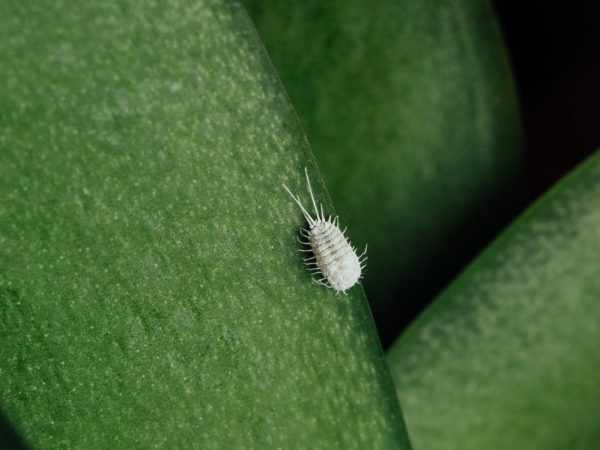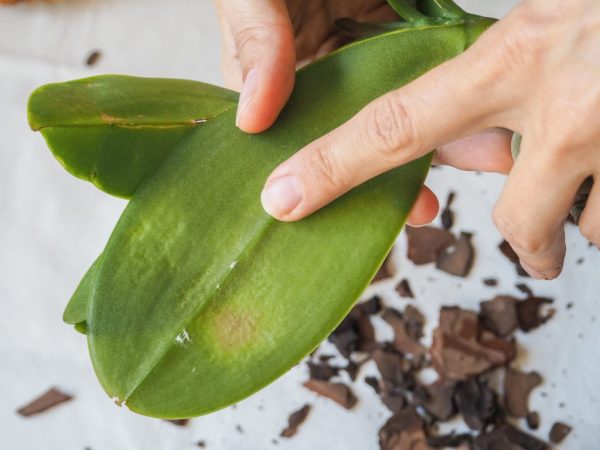Ways to combat aphids on an orchid
An orchid is a flower that needs proper care. The plant is attacked by thrips, ticks, worms and other parasites. One of the most common problems is aphids on an orchid, so it is important to know the causes of aphids and how to get rid of them at home.

Ways to combat aphids on an orchid
Reasons for the appearance
Usually, aphids on orchids appear due to unsuitable conditions of detention: a dry climate, a lack or excess of useful trace elements. But it can appear in other ways:
- insects were originally on a flower in a flower shop;
- the pests were in the soil;
- the parasites have moved to the flower from neighboring plants.
When buying a flower in a store, you need to carefully examine all the leaves and other parts of the plant, and also check the substrate for the presence of parasites.
The appearance of aphids from the soil is possible in cases where the land is taken from the yard, therefore, special soil purchased in stores is used to transplant the orchid. It is also important to keep an eye on other plants in the house to avoid the spread of pests.
Signs
If small green or black insects are visible on flowers, buds, stems, shoots and on the back of young leaves, this is aphid. Sometimes it is white. From its vital activity, the leaves lose their shape, decorativeness, curl, a sticky bloom appears.
The shoots on which flowers are formed wither and fall off. Another sign of pests is dark spot spreading along the stem.
One of the features of these insects is the ability to shed. White scales on phalaenopsis leaves are a sign of parasites.
Aphid damage
Aphids first attack the leaves of the plant, then the stem, buds and flowers, since these parts are the most juicy. It sucks out all the trace elements necessary for the normal growth of the flower. Another feature of these parasites is their rapid reproduction. They form colonies, which are usually found in areas where new leaves grow.
In the process of feeding, insects release toxic substances into the plant. Because of this, the process of distribution of nutrients and photosynthesis are disrupted in the flower. The affected parts of the plant soften and die after a while. In the worst case, the entire phalaenopsis dies.
Prevention of the appearance

Avoid dryness
To prevent the appearance of aphids on phalaenopsis, preventive measures are taken. Insects reproduce quickly in dry climates and do not tolerate humid air; the humidity level is constantly monitored in the room. The appropriate level is 55%. Humidity will not only save the flower from the attack of pests, but will also promote rapid growth.
Watering and moisture
Be sure to monitor the condition of the soil, preventing drying out: the flower is watered every week. It is advisable to spray it with warm water: this prevents the reproduction of aphids.
Moisture should not accumulate on leaves and buds, because excess provokes the appearance of pests.
Nutrients
Lack or excess of beneficial trace elements contribute to the appearance of aphids. An orchid needs certain nutrients for normal growth, such as iron. If it is not enough in the plant's body, immunity decreases, and the weakened flower becomes a target for pests.
A large amount of nitrogen in the soil provokes the appearance of parasites, so you need to take seriously the choice of mixtures and preparations for fertilizing the flower and adhere to the dosage rules. Good feeding helps to strengthen the immune system, which effectively resists and fights against diseases and pests. She is able to heal damaged areas.
Sanitary and hygienic measures
Check your orchid regularly for parasites. At the initial stage, it is easy to get rid of aphids by treating the flower with special means. The affected parts of the plant should be removed to prevent the spread of toxic substances.
After buying a new flower, it is advisable to remove it in a separate place and keep it away from other indoor plants for several days to make sure that there are no pests on it. The transplant should be carried out only in a disinfected substrate and a pot.
Ways to fight
If aphids appear on the phalaenopsis, it is necessary to get rid of it as soon as possible before it causes colossal damage to the flower. Aphids are removed in two ways: by the folk method or by chemicals.
Traditional methods
Traditional methods help to cure the flower only at the initial stage of the appearance of aphids. For this, decoctions, infusions and solutions are prepared. The most common remedies:
- Treatment with soapy water. It helps to heal the flower: the laundry soap is dissolved in warm water (1 tbsp. Of soap falls on 1 liter). To make the soap dissolve more easily, cut it into pieces or rub it on a grater. The flower is manually processed with a sponge.
- Processing with citrus waste infusion. The peel of any citrus fruit is poured with boiling water and infused for 3 days. Proportions: 100 g of zest per 1 liter of water.
- Processing with onion infusion. 1 medium onion is poured with 1 liter of boiling water. After that, the mixture is insisted for 3 days, cooled and filtered. The orchid is treated with a spray bottle.
- Processing with rosehip infusion. The infusion is prepared by soaking the fruit in warm water, infused for one day and boiled for 30 minutes. Proportions: for 1 liter of water 15 g of fruits. The infusion is sprayed once a week.
After applying any of the above means, observe the orchid for 2 weeks. If the aphid has not died, they resort to chemical treatment so that it does not attack other parts of the flower.
Chemicals
It is necessary to treat the orchid with chemicals in cases of mass destruction. There are 3 types of drugs: contact, intestinal and systemic. All of them differ in the way they act on aphids: the first act on the skin of pests, and the second and third - on the body from the inside. The most effective drugs are intestinal and systemic: up to 98%. The effectiveness of contact chemicals is 90%.
Any insecticides alternate, taking a break of 1.5-2 weeks, and do not use more than 3 times. The constant use of the same drug is addictive in insects. In order not to harm the orchid, it is treated in the doses indicated on the package.
Conclusion
Aphids are a serious problem for an orchid, since they can greatly harm the flower and even lead to its death. Pests are fought with folk methods, using natural solutions and infusions, or with chemicals. In the second case, it is imperative to adhere to the rules for using insecticides so as not to harm the plant.


